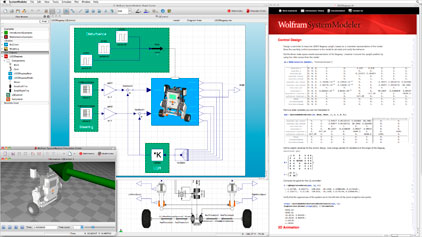 The company says the release of SystemModeler launches a new era of integrated design optimization.
The company says the release of SystemModeler launches a new era of integrated design optimization.
The Wolfram Group has announced the release of Wolfram SystemModeler — the high-fidelity modeling environment that uses versatile symbolic components and computation to drive design efficiency and innovation.
Traditional systems have focused on optimization just within the modeling feedback loop. Instead, SystemModeler integrates with the Wolfram technology platform to enable modeling, analysis (of many types), and reporting, all together achieving the first fully agile design optimization loop.
"Agility to iterate between modeling and engineering phases will be a key driver of tomorrow's design optimization," says Roger Germundsson, director of research and development at Wolfram. "The Wolfram solution uniquely puts these together into an integrated design.
Many of today's tools are limited in their fidelity by their foundations: using block diagrams that poorly represent key components, and producing models just for simulation and not engineering analysis. Moreover, computation is numerics-only or not integrated at all. It's the SystemModeler approach of versatile symbolic components backed by the ultimate computation environment that enables an all-in-one integrated workflow.
"You wouldn't build a skyscraper just with stone blocks, so why model your future innovations just with block diagrams," says Jan Brugård, CEO of Wolfram MathCore and SystemModeler Manager.
"Symbolic components provide the full gamut of high-fidelity representation. Be empowered to think the unthinkable — and then test it out."
"If you think models are just for modeling, you're missing the future of design optimization," continues Brugård. "Instead, build the high-fidelity model once for modeling, simulation, and analysis. Computation isn't an optional extra, it's central to the infrastructure of modern model optimization."
Wolfram computation technology has been renowned for driving automation, unification, and other key principles across apparently disparate workflows, achieving dramatic improvements in innovation. The acquisition of MathCore and this first stage in the integration of SystemModeler into the Wolfram platform extends those principles to systems engineering — driving insight, innovation, and results.
"I'm excited to see technologies as diverse as linguistic querying, computable documents, symbolic computations, and the world's most advanced statistical analysis start to combine with SystemModeler into a single, integrated design workflow," said Conrad Wolfram, director of strategic and international development at Wolfram. "We're late to systems engineering but right at the start of the new era of integrated design optimization. We've got an unrivaled technology stack for implementing this change."




